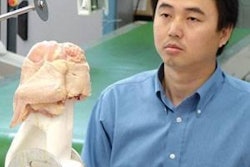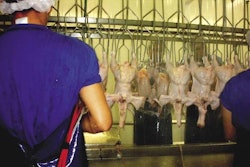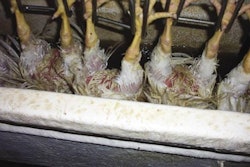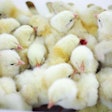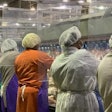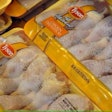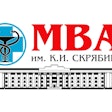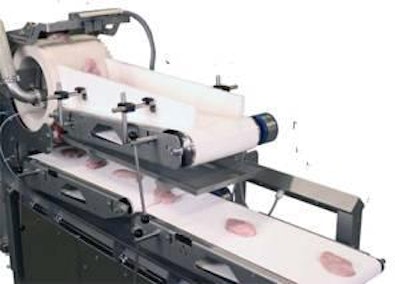
The poultry industry has a long and well documented history of process innovations. These started with shackle line material handling systems, feather pickers and immersion chillers in the 1940s and 1950s, through automatic eviscerating equipment and cut-up machines in the 1960s and 1970s to the introduction of automatic de-boning, portioning and sorting devices, weigh/price labellers, sorters and cooking and freezing systems in the 1980s and 1990s. Plants have drawn on an array of technologies to increase labour efficiency, processing throughput and processing consistency, while extending limited resources to help take on an ever expanding array of value-added activities. These technologies have also sometimes created islands of automation, which proved difficult to automate because of their complexity.
Equipment manufacturers and researchers focus on growing food safety challenges, continuing difficulties in fully staffing plant processing operations, expanding portion and product quality demands, limited resources and the ever-greater need for flexibility. Meanwhile, a new generation of technologies is emerging to tackle many of these limitations of the past. New technologies promise more fully integrated plant operations.
Reducing islands of automation
One of the earliest successes in bridging islands of automation occurred in the late 1980s with the introduction of the automatic transfer machine between the killing and eviscerating lines. Until then, speed synchronisation problems between the two lines required manual transfer of product. Automatic transfer machines brought significant labour savings and helped to demonstrate the value of linking automation systems together.
A more recent success in bridging islands of automation has been the emergence of the flexible cut-up line. This links a series of automatic cutting devices that can be employed or by-passed as necessary. It lets plants maximise the value of the product being processed dynamically, while reducing labour demands.
A number of new equipment releases are also helping bridge islands of automation in the further processing area of plants. Some plants have either installed or are considering air chillers in place of immersion chillers. While the primary focus of these decisions has been to target product quality and safety interests related to select market sectors, air chiller systems also provide an automatic transfer bridge between two notorious islands of automation the evisceration line and the pack-out/cut-up line. Researchers at Georgia Tech are working to bridge this gap on immersion chiller systems by using an intelligent transfer device that employs computer vision technology, a series of orientation devices and a shackle transfer module to automatically make the transfer. Significant labour savings are possible with both systems.
Another research team from Georgia Tech, the University of Georgia and the USDA Agricultural Research Service is focusing on automating the live-bird transfer process at the front end of plants. Again, using computer imaging and intelligent grasping devices and automatic shackling technology, this system promises to reduce labour significantly while also enhancing control over the quality of product exiting this operation.
Intelligence about product quality and safety
One of the earliest examples of in-line intelligence was the overhead, in-line scale system introduced in the early 1980s. These systems provided a means of automatically sorting product on-the-fly by weight grade. Their subsequent counterpart is the belt weigh-sorter that is now commonplace throughout the industry. These newer devices weigh belt-conveyed product on-the-fly and remove them from the line based on weight grade. They have helped the industry revolutionise control over meeting ever tightening portion demands while also introducing significant savings.
Other examples of systems that have been introduced to provide intelligence regarding the quality and safety of in-process product include X-ray scanners and metal detectors. Metal detectors have proven to be a workhorse in all processing plants, while X-ray systems have struggled to maintain a place in plants because of screening accuracy limits in detecting bone and cartilage in de-boned product.
Another emerging powerhouse technology for providing in-process product quality and safety is computer vision technology. Initially introduced to processing plants with automatic portioning technical processes, this technology has proven elusive in finding its way more broadly into quality and safety screening and control. After years of research and recent improvements in camera, lighting and computer technology, colour imaging systems are coming of age for the poultry industry. At the last International Poultry Exposition in Atlanta, at least six colour-based vision systems were on display for commercial sale (from Gainco, Stork, Meyn/Systemate, GBR and Linco). All of these systems are currently being targeted at whole-bird screening for visual defects.
Researchers at Georgia Tech have now gone beyond this focus area, developing a number of computer vision systems to screen de-boned meat for fan bones, in-process product for plastic foreign objects, in-process cooked product for colour, shape and quality appearance, and cooked product (using infra-red cameras) for temperature quality. Those researchers have also recently worked with Cryovac to develop an automated screening system to inspect the integrity of seals on over-wrap trays for food safety and security assurance.
All systems provide savings by automating many of the manual screening activities currently taking place in plants. Their real value, however, is in providing accurate and consistent screening information on 100% of the product and their ability to electronically communicate these findings to a computer database and/or a machine providing direction on how to optimise process operations.
Tackling complex steps not yet automated
One of the toughest problems facing traditional poultry processing automation technology has been their limited ability to deal with product variability and/or complex tasks that call for sight or touch feedback to perform the activity effectively. One of the earliest devices to tackle this challenge was the automatic portioning machine introduced in the late 1980s. For the first time, a cutting task was automated by asking a computer vision system to provide precise volume and shape information on each product to a computer that used the information to decide how to cut that product optimally, and sent directions to a robot-controlled water-jet knife. Over the years, these portioning machines have gained features and newer designs have metal blades. Automation saves labour for sure but also provides cutting accuracies and consistencies unmatched by manual processes.
Another area receiving focus from designers and researchers is the de-boning task. Automatic de-boners were first introduced in the 1980s and were quickly employed by many operations to reduce mounting labour costs related to growing demand for de-boned product. Plant managers soon realised that their de-boning machines were not producing the yield that they had been achieving with manual de-boning. When efforts were made to increase yield, bone fragments in the product also increased. Frustrated by their inability to find a happy medium, most plants removed these devices in the mid-1990s and returned to manual de-boning operations.
Equipment designers continued to work on improvements, but a more cautious industry has been slow to embrace the new releases. Improvements in thigh and leg de-boning systems have won many plants back to using automatic de-boners as part of their operations. Automatic breast de-boning equipment, however, has struggled for acceptance.
Stork's latest breast de-boning system takes a different approach to controlling the cuts, and initial response has been favourable. Georgia Tech researchers are also working in this area, trying to develop intelligent cutting techniques that respond to subtle differences in each product, using computer vision and tactile feedback to help control the cut trajectory on each carcass. Early prototype systems use on-board robotic actuators to adjust the cutting motion using input and feedback information. Success in this area will help the industry achieve significant labour savings, increase overall potential yield and reduce the risk and safety hazard of bone fragments in products.
In the area of product packaging, a number of interesting advances are emerging. All of the new equipment offers labour savings by automating product handling. The three robotic systems described signal the emergence of robots as a viable technology for poultry processing operations. New equipment designs continue to improve to meet the speeds and demands of today's operations. Robotics is another emerging technology for material handling tasks in processing operations.
What of the future?
With the growing abilities of robotics, computer vision and advanced sensors, a new generation of intelligent processing systems is emerging for poultry processing operations. These offer the potential to improve integration of the processing plant floor while delivering labour savings and better abilities to manage product and process variability automatically. Commercial offerings are beginning to surface that meet the demanding cost and dependability requirements of the industry.
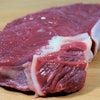
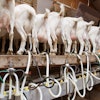
.jpg?auto=format%2Ccompress&fit=crop&h=167&q=70&w=250)
